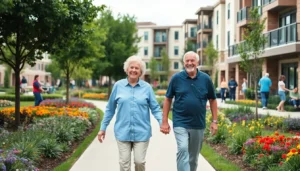As the golden years approach, many seniors find themselves dreaming of a garden oasis that’s both beautiful and easy to maintain. Picture this: a vibrant landscape that doesn’t require a degree in horticulture or a personal trainer to manage. Senior-friendly landscaping is all about creating a space that’s not just visually appealing but also accessible and low-maintenance.
Imagine strolling through a garden where every flower is a friendly companion, and every path is a gentle guide. With the right design, seniors can enjoy nature without the backaches and knee pains. From raised garden beds to strategically placed seating areas, senior-friendly landscaping transforms outdoor spaces into havens of relaxation and joy. It’s time to turn those dreams into reality—because who says gardening can’t be a walk in the park?
Table of Contents
ToggleUnderstanding Senior-Friendly Landscaping
Senior-friendly landscaping prioritizes features that enhance accessibility and safety. These designs enable seniors to engage with their outdoor spaces comfortably.
Importance of Accessibility
Accessibility in landscaping significantly impacts seniors’ ability to enjoy their gardens. Pathways should be wide enough, ideally at least 36 inches, to accommodate walkers and wheelchairs. Flat surfaces minimize the risk of tripping while ensuring easy navigation through outdoor areas. Utilizing non-slip materials for surfaces also enhances safety during wet conditions. Additionally, raised garden beds positioned at height of 24 to 36 inches allow for easier planting and maintenance without excessive bending. Incorporating seating at strategic locations encourages relaxation and enjoyment of the surroundings.
Safety Considerations
Safety remains a crucial element in planning senior-friendly landscapes. Proper lighting, especially along pathways and near entry points, helps avoid falls during dusk or evening hours. Install handrails on steps and slopes for additional support while traversing uneven terrain. Plants should be chosen carefully, avoiding thorny or invasive species that might pose hazards. Employing durable, low-maintenance materials reduces the need for frequent repairs, minimizing any potential injuries. Regular maintenance of lawns and pathways ensures a safe environment, enabling seniors to enjoy their outdoor spaces with confidence.
Key Features of Senior-Friendly Landscaping
Senior-friendly landscaping incorporates elements that enhance accessibility and ease of maintenance. These features create inviting outdoor spaces for seniors to enjoy comfortably and safely.
Low-Maintenance Plants
Choosing low-maintenance plants simplifies garden upkeep for seniors. Consider native plants that adapt well to local conditions. Ground covers reduce weeding efforts while adding aesthetic appeal. Perennials offer seasonal blooms without the need for annual replanting. Drought-resistant varieties conserve water and minimize care. Selecting these types of plants fosters a thriving garden with less work.
Safe Pathways and Surfaces
Safe pathways significantly impact mobility and accessibility. Visitors should find pathways at least 36 inches wide to accommodate walkers and wheelchairs easily. Non-slip surfaces, such as textured concrete or pavers, minimize the risk of falls. Incorporating curves instead of sharp corners enhances visual interest while keeping the journey safe. Installing adequate lighting along paths ensures visibility during evening hours.
Comfortable Seating Areas
Comfortable seating areas provide spaces for relaxation and socializing. Benches with back support and armrests cater to seniors’ needs. Positioning seats near gardens or under trees showcases beautiful views and offers respite from the sun. Accessible seating should include a minimum height of 18 inches from the ground for easy transfer. Adding cushions enhances comfort, inviting seniors to enjoy their gardens longer.
Design Tips for Senior-Friendly Landscaping
Designing a senior-friendly landscape involves thoughtful approaches to ensure accessibility and enjoyment. Key elements such as color, texture, raised garden beds, and shade can significantly enhance outdoor spaces.
Use of Color and Texture
Bright colors attract attention and create a lively atmosphere in gardens. Choosing bold flowers, such as daylilies or sunflowers, can evoke joy and stimulate the senses. Textures also play a crucial role; combining smooth surfaces, like ornamental grasses, with rough ones, like bark mulch, creates visual interest and tactile variety. Plant arrangements should consider seasonal blooms for continual beauty. Accessibility should guide plant placement, ensuring easy visibility from seating areas. Such vibrant and textured environments can uplift spirits and encourage outdoor engagement.
Incorporating Raised Garden Beds
Raised garden beds provide practical benefits for seniors. Heights of 24 to 36 inches allow gardeners to tend to plants without excessive bending or stretching. Customizing the width can enhance reachability, minimizing strain on the body. Using durable materials, such as rot-resistant wood or composite options, ensures longevity. Positioning these beds near seating areas fosters a nurturing experience where seniors can relax while gardening. Incorporating wheels into some designs allows mobility, enabling gardeners to move beds for optimal light exposure. This flexibility supports enjoyable gardening without physical discomfort.
Providing Shade and Shelter
Shade structures, such as pergolas and shade sails, offer essential relief from harsh sunlight. Positioning these structures strategically can create cool spaces for relaxation and social interaction. Additionally, trees with broad canopies can protect garden areas and pathways from the sun. Opting for plants with large leaves helps in providing natural shade while enhancing overall aesthetics. A shaded seating area encourages gatherings with family and friends, promoting a sense of community in outdoor spaces. Incorporating windbreaks can also shield areas from harsh weather, ensuring a comfortable environment year-round.
Benefits of Senior-Friendly Landscaping
Senior-friendly landscaping offers multiple benefits that cater to the needs of older adults, providing opportunities for relaxation, exercise, and social engagement.
Enhancing Quality of Life
Senior-friendly landscapes enhance quality of life by creating serene outdoor spaces. Beautiful gardens allow individuals to enjoy nature, which can reduce stress and improve mental well-being. Comfortable seating areas provide spots for rest, enabling seniors to appreciate their surroundings without strain. Accessibility features such as wide pathways and raised garden beds further promote ease of mobility, ensuring that seniors can experience their yards without difficulty.
Encouraging Physical Activity
Encouragement of physical activity stems from engaging landscapes designed for seniors. Simple tasks like watering plants or harvesting vegetables foster movement, contributing to overall fitness. Raised garden beds minimize bending and stretching, making gardening more enjoyable and accessible. Incorporating safe pathways for walking or light exercises creates an inviting environment that encourages seniors to stay active, promoting better health outcomes.
Promoting Social Interaction
Promoting social interaction takes center stage in senior-friendly landscaping. Gathering spaces with adequate seating encourage friendships and family connections. Gardens that feature vibrant plants and inviting designs can draw neighbors and visitors, leading to shared enjoyment of the outdoors. Hosting small gatherings or simple conversations beneath shade structures further enhances community engagement, enriching the social lives of seniors while fostering a sense of belonging.
Conclusion
Creating a senior-friendly landscape is essential for enhancing the outdoor experience for seniors. By prioritizing accessibility and safety, seniors can enjoy their gardens without the worry of physical strain. Thoughtful design elements like raised beds and safe pathways not only facilitate gardening but also promote relaxation and social interaction.
Incorporating low-maintenance plants and comfortable seating further enriches these outdoor spaces. Ultimately, a well-designed landscape can significantly improve seniors’ quality of life, fostering a sense of community and well-being. Embracing these principles allows seniors to fully enjoy the beauty of nature while maintaining their independence and comfort.








